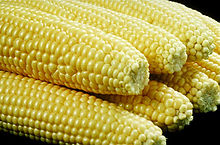Zeaxanthin
| Structural formula | |||||||||||||||||||
|---|---|---|---|---|---|---|---|---|---|---|---|---|---|---|---|---|---|---|---|

|
|||||||||||||||||||
| General | |||||||||||||||||||
| Surname | Zeaxanthin | ||||||||||||||||||
| other names |
|
||||||||||||||||||
| Molecular formula | C 40 H 56 O 2 | ||||||||||||||||||
| Brief description |
orange-yellow crystals with a steel blue, metallic sheen |
||||||||||||||||||
| External identifiers / databases | |||||||||||||||||||
|
|||||||||||||||||||
| properties | |||||||||||||||||||
| Molar mass | 568.89 g mol −1 | ||||||||||||||||||
| Physical state |
firmly |
||||||||||||||||||
| Melting point |
215 ° C |
||||||||||||||||||
| solubility |
|
||||||||||||||||||
| safety instructions | |||||||||||||||||||
|
|||||||||||||||||||
| As far as possible and customary, SI units are used. Unless otherwise noted, the data given apply to standard conditions . | |||||||||||||||||||
Zeaxanthin is a natural, orange-yellow dye that plays a role in plants and animals in reactions to light radiation. Chemically, zeaxanthin is a xanthophyll , an oxygen-containing carotenoid ( "oxidized β-carotene" ). The substance is approved as E 161h in the EU as a feed additive.
Occurrence
Of course, zeaxanthin occurs as a yellow dye in corn kernels, spinach, egg yolks and many types of vegetables. Zeaxanthin can also be found in the yellow feathers of canaries.
Extraction and presentation
While zeaxanthin is found in some plants, it is also synthetically produced for medicinal purposes and as a food coloring.
properties
Chemical properties
Zeaxanthin belongs to the group of xanthophylls , which are a group of carotenoids . The compound is sparingly soluble in petroleum ether and water (<1 mg / l at 20 ° C), but soluble in methanol , ethyl acetate and chloroform . Zeaxanthin is structurally similar to carotenes such as beta-carotene.
Isomerism
Zeaxanthin has two centers of chirality and three isomers, since (3 R , 3 ' S ) and (3 S , 3' R ) are identical to one another due to their symmetry. The (3 R , 3 ′ R ) isomer occurs most frequently in nature. The second most common isomer, (3 R , 3 ′ S ) -zeaxanthin, is known as meso-zeaxanthin .
use
Zeaxanthin is used as:
- Ingredient in preparations for the dietary treatment of age-related macular degeneration
- for animal feed (premixes, feed mixes)
Biological importance
Zeaxanthin, together with its isomer lutein, occurs as a pigment in the retina , especially in the yellow spot ( macula lutea ) and acts as a filter to protect the retina from excessive light. Recently, zeaxanthin has been gaining increasing interest in medicine as it may have a protective effect on certain forms of retinal degeneration, particularly age- related macular degeneration (AMD), based on the antioxidant activity of the compound.
In plants, zeaxanthin plays an important role in converting light into heat, so that the plant is not damaged by high radiation intensity ( xanthophyll cycle ).
Finished preparations
z. E.g .: Avilut, Ocuvite, Augenfit capsules etc.
Web links
- Information on lutein and zeaxanthin intake at Pro Retina Deutschland e. V.
- Datasheet Zeaxanthin at Chemicalland21
- Whitehead et al .: Macular Pigment. A Review of Current Knowledge. Arch. Ophthalmol. 2006; 124: 1038-1045.
Individual evidence
- ↑ Entry on ZEAXANTHIN in the CosIng database of the EU Commission, accessed on February 25, 2020.
- ↑ a b c d Entry on zeaxanthin. In: Römpp Online . Georg Thieme Verlag, accessed on April 10, 2014.
- ↑ a b Data sheet Zeaxanthin from Sigma-Aldrich , accessed on February 12, 2019 ( PDF ).
- ↑ Joachim Buddrus, Bernd Schmidt: Fundamentals of Organic Chemistry , 5th Edition, de Gruyter Verlag, Berlin, 2015, p. 843, ISBN 978-3-11-030559-3 .

